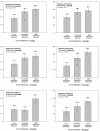Exercise, physical activity, and self-determination theory: a systematic review
- PMID: 22726453
- PMCID: PMC3441783
- DOI: 10.1186/1479-5868-9-78
Exercise, physical activity, and self-determination theory: a systematic review
Abstract
Background: Motivation is a critical factor in supporting sustained exercise, which in turn is associated with important health outcomes. Accordingly, research on exercise motivation from the perspective of self-determination theory (SDT) has grown considerably in recent years. Previous reviews have been mostly narrative and theoretical. Aiming at a more comprehensive review of empirical data, this article examines the empirical literature on the relations between key SDT-based constructs and exercise and physical activity behavioral outcomes.
Methods: This systematic review includes 66 empirical studies published up to June 2011, including experimental, cross-sectional, and prospective studies that have measured exercise causality orientations, autonomy/need support and need satisfaction, exercise motives (or goal contents), and exercise self-regulations and motivation. We also studied SDT-based interventions aimed at increasing exercise behavior. In all studies, actual or self-reported exercise/physical activity, including attendance, was analyzed as the dependent variable. Findings are summarized based on quantitative analysis of the evidence.
Results: The results show consistent support for a positive relation between more autonomous forms of motivation and exercise, with a trend towards identified regulation predicting initial/short-term adoption more strongly than intrinsic motivation, and intrinsic motivation being more predictive of long-term exercise adherence. The literature is also consistent in that competence satisfaction and more intrinsic motives positively predict exercise participation across a range of samples and settings. Mixed evidence was found concerning the role of other types of motives (e.g., health/fitness and body-related), and also the specific nature and consequences of introjected regulation. The majority of studies have employed descriptive (i.e., non-experimental) designs but similar results are found across cross-sectional, prospective, and experimental designs.
Conclusion: Overall, the literature provides good evidence for the value of SDT in understanding exercise behavior, demonstrating the importance of autonomous (identified and intrinsic) regulations in fostering physical activity. Nevertheless, there remain some inconsistencies and mixed evidence with regard to the relations between specific SDT constructs and exercise. Particular limitations concerning the different associations explored in the literature are discussed in the context of refining the application of SDT to exercise and physical activity promotion, and integrating these with avenues for future research.
Figures


References
-
- Physical activity guidelines advisory committee report. U.S. Department of Health and Human Services, Washington DC; 2008.
-
- Sport and Physical Activity. Special Eurobarometer, 334/Wave 72.3; 2010. Eurobarometer: Sport and Physical Activity.
-
- Prevalence of Regular Physical Activity Among Adults—United States, 2001 and 2005. MMWR. 2007;56:1209–1212. - PubMed
-
- Colley RC, Garriguet D, Janssen I, Craig CL, Clarke J, Tremblay MS. Physical activity of Canadian Adults: Accelerometer data from the 2007 to 2009 Canadian Health Measures Survey. Statistics Canada, Health Reports 2011 22, Catalogue no. 2011;22:82–003. - PubMed

